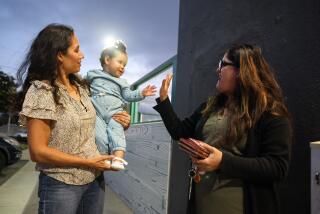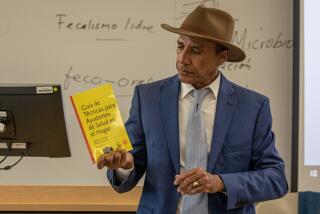If Words Could Cure Them
SANTA PAULA — Toggling between two languages is nothing new for Gabriela Martinez, who often translates documents and phone calls for her Spanish-speaking mother and family friends.
But the 17-year-old admitted to having moments of doubt upon arriving at Santa Paula Hospital for her first day of volunteer work.
“I felt like, ‘Oh my God, what if I can’t translate, what if I can’t do it?’ ” Gabriela said.
Her fears dissipated moments later when a social worker called and asked her to translate for two women: an Alzheimer’s patient and her caretaker.
“The first time she [the social worker] asked me something, it was easy,” said Gabriela, sitting at a desk in the medical/surgical department, sporting the hospital-issued white lab coat over her black jeans and Nikes.
The teenager is one of 27 Santa Paula High School students who have volunteered to translate between Spanish-speaking patients and English-speaking medical personnel as part of a program launched in December by school and hospital officials.
The project began as a way to return a favor. Hospital workers often come to the high school to talk with students in child-development or health classes.
“What can we do for you?” Principal Jose Antonio Gaitan recalls asking.
“We need translators,” he was told.
According to the 1990 census, the Latino population in Ventura County is growing faster than any other ethnic group, and in a town like Santa Paula, where Latinos are the majority, knowing Spanish is increasingly important, hospital workers said.
‘I work in OB and about 50% [of the patients], at least, speak in Spanish,” said Carol Lundstrom, an obstetrics nurse. “The majority of the RNs are typically white females, many of whom had little Spanish in high school.”
Lundstrom says she and other nurses try to use the Spanish phrases they know but usually depend heavily on other workers to translate.
The hospital has numerous workers who speak Spanish, but it lacks full-time translators. Patients often express how grateful they are that there’s someone to interpret, when they can’t explain to doctors or other workers how they’re feeling, said Virginia Reyes, who works in patient accounts but also serves as a translator.
Though Reyes and other workers are happy to provide the service, they say they welcome the help of students, because translating can be time-consuming and requires their own work be put on hold.
School administrators offered their best Spanish-language students for the program. Last year’s advanced-placement class scored exceptionally well on its Spanish tests, with all 18 who took the AP exam receiving college credit. Fifteen of the students earned a 5, the top score, while the other three students received a 4, said the school principal.
*
With the new volunteer program in place, students are paged to assist in any hospital department, including radiology, the emergency room and laboratory. They offer their assistance after school and on weekends.
During lag time, students sit in a small room, adjacent to the nurses’ station in the medical/surgical department, writing Spanish versions of hospital forms.
As the first generation of her family to be born in the U.S., Gabriela often translates for her mother, a homemaker, born in Aguascaliente, Mexico. Though her father speaks English, he’s often at work and can’t always translate for her mom.
“We’re so proud that she can speak in two languages,” said her mother, Luz Martinez, in Spanish. “She always translates letters and government papers for us. She just loves to help the people.”
More to Read
Sign up for Essential California
The most important California stories and recommendations in your inbox every morning.
You may occasionally receive promotional content from the Los Angeles Times.









